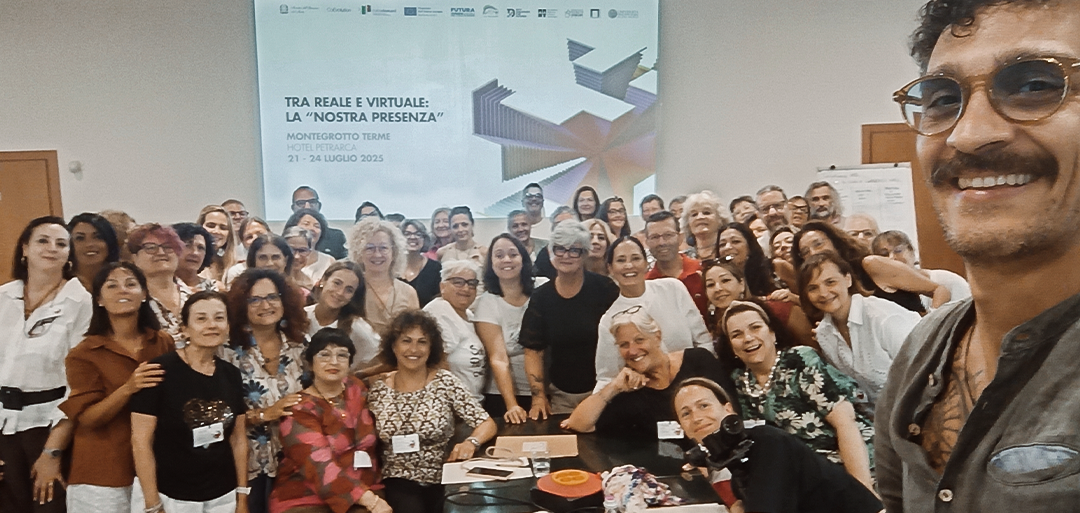AANT took part in the training week “Tra reale e virtuale: la nostra presenza”, held from 21 to 24 July 2025 at Hotel Petrarca in Montegrotto Terme. The initiative, organized within the framework of the national network Dialogues for Futures (RD4F) and supported by PNRR funding (Education Mission – Futura. La Scuola per l’Italia di domani program), brought together teachers, school leaders, and administrative staff (DSGA) from across Italy for a series of workshops and dialogues on educational innovation. AANT’s participation in this significant event offered a valuable opportunity for exchange and professional growth, reaffirming the Academy’s commitment to developing and sharing cutting-edge educational practices in a spirit of open and positive collaboration.
The AANT delegation, led by General Director Rossana Quarta and Scientific Director Gianna Angelini, included six faculty members serving as speakers and tutors. In addition to Quarta and Angelini, the team featured Ana Gabriela Llarin (Didactic Coordinator and Creative Director), Valerio Di Paola (Didactic Coordinator), Matteo Quarta (Videomaking Lecturer), and Claudia Primangeli (Photography Lecturer). AANT professionals played a central role throughout the week, sharing their expertise in both plenary sessions and hands-on workshops for the direct benefit of all participants.
During the training week, the AANT team led three immersive workshops, offering participants practical tools and innovative methodologies for multimedia teaching and communication:
- Progettare e realizzare presentazioni visive, led by Ana Gabriela Llarin, focused on visual design techniques for creating engaging and shareable educational content.
- Raccontare con i reel, conducted by Matteo Quarta (with the support of videomaker Laura Santini), explored the creative use of short videos and social media to effectively and “smartly” communicate school projects and initiatives.
- Transmedialità: Strategie per una comunicazione integrata, led by Valerio Di Paola, examined how to coordinate various online and offline channels to build a coherent, participatory, and inclusive school communication strategy.
These workshops allowed participants to experiment with new expressive formats and learn strategies to extend the school’s presence both in physical space and in digital environments. The enthusiasm and engagement demonstrated by participants throughout the sessions highlighted the effectiveness of a hands-on, collaborative learning approach—learning by doing and sharing.
In addition to the workshops, AANT experts contributed to the event’s plenary sessions with presentations and case studies drawn from best educational practices developed within the RD4F network. At the opening session, Rossana Quarta presented “Discovering Machiavelli”, an innovative educational project aimed at developing digital skills and literacies to explore the physical and symbolic dimensions of the school environment. Claudia Primangeli showcased a school-based photography project focused on the regeneration of learning environments, illustrating how photographic art can foster active participation and a sense of belonging among students.
These contributions were part of the introductory panel “La ‘presenza’ della rete: percorsi e laboratori arte, cittadinanza e transizione digitale 2024/25”, dedicated to sharing the outcomes of projects developed by schools in the Dialogues for Futures network over the past academic year. Later in the week, Gianna Angelini moderated an in-depth dialogue on the theme of presence together with Giovanna Barzanò (Scientific Coordinator of RD4F and AANT President) and Rossana Quarta. The conversation explored the strategic role of school networks in fostering cohesive and forward-looking educational communities. Angelini also delivered a keynote titled “IA generativa e prospettive future”, examining the opportunities and challenges posed by the introduction of Generative Artificial Intelligence in education.
The concept of “presence” in contemporary education served as the central theme of the Montegrotto training week. Throughout the event, participants discussed the importance of cultivating a strong social and cognitive presence in the school community. This means involving students as active agents in the learning process (e.g., through co-created multimedia projects) while also supporting teachers’ agency—their ability to innovate and positively impact the educational context.
All proposed activities were grounded in this vision. Participants explored participatory methodologies such as trialogical learning, where the shared creation of artefacts (presentations, videos, storytelling) serves as both process and product. They also reflected on active teaching strategies inspired by public history and citizen science, applied to classroom practice. Significant attention was devoted to the mindful use of emerging technologies. Generative Artificial Intelligence, for instance, was not approached as a mere trend but rather as an opportunity to rethink the roles of teachers and students. The aim is to harness AI’s innovative potential while ensuring that human presence and interaction remain central to the educational experience.
In every session and workshop, the human dimension of presence was consistently emphasized: building authentic relationships, stimulating curiosity, promoting inclusion, and encouraging dialogue. In short, being meaningfully present in the learning process.
